 Learning to dress independently is an important life skill. It gives your child a sense of achievement to master a new skill.
Learning to dress independently is an important life skill. It gives your child a sense of achievement to master a new skill.
First your child will be able to help you as you dress them. They will hold out a foot for you to put a sock on and push their arms through their sleeves. Next they will learn to undress. They will be able to take off socks, pyjamas and anything without fastenings.
Then they will learn to put on clothing without fastenings. Then they will be able to take off and put on their clothes with some help with fastenings. Finally they will manage fastenings by themselves.
 Involve your child in undressing and dressing. You can do this when they are babies. Talk about what you are doing. Name body parts. Sing songs about dressing. Follow the same routine. Your baby will get to know what is coming next. Be playful. Put their socks on your ears or on their hands. Let them make a choice about what to wear. "Do you want the blue t-shirt or do you want the red t-shirt?".
Involve your child in undressing and dressing. You can do this when they are babies. Talk about what you are doing. Name body parts. Sing songs about dressing. Follow the same routine. Your baby will get to know what is coming next. Be playful. Put their socks on your ears or on their hands. Let them make a choice about what to wear. "Do you want the blue t-shirt or do you want the red t-shirt?".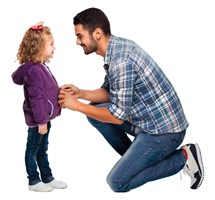 Children learn in different ways so you might need to vary your approach. There are different ways you can help:
Children learn in different ways so you might need to vary your approach. There are different ways you can help:Physically assist your child. Put your hands over your child's and help them to get dressed.
Show your child. Put your clothes on at the same time as your child and show them what to do.
Tell your child. Talk your child through the steps.
Try each of these ways to find what works for your child. Sometimes you might need to use more than one of these methods. Please remember that some children cannot look and listen at the same time. You are aiming to give the least amount of support needed. If you start by physically helping your child, work towards showing them what to do. Then work towards telling them what to do.
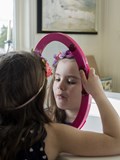 Instead of automatically correcting a mistake (e.g. twisted collar or button incorrectly matched) why not encourage your child to look in the mirror and get them to find out what's wrong. You may need to ask them some questions to help them work it out.
Instead of automatically correcting a mistake (e.g. twisted collar or button incorrectly matched) why not encourage your child to look in the mirror and get them to find out what's wrong. You may need to ask them some questions to help them work it out.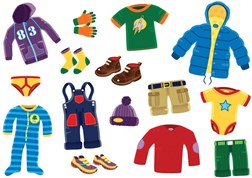 Order of Dressing
Order of DressingAll children need to learn what order to put their clothes on in. They need to know that their pants go on before their trousers. Unless they want to dress up as a superhero! Find more information about teaching the order of dressing in the information sheet. You can also download some visual aids for the morning routine.

Downloadable morning routine sequence cards for you to print off and use.
 When teaching a new skill we often start at the beginning. This can be challenging for children sometimes as they get frustrated. You can give your child a sense of achievement by using the backward chaining technique. Backward chaining is particularly useful when learning self-care skills like dressing. It can also be helpful when teaching younger children. It is also useful when someone is having difficulty learning new skills.
When teaching a new skill we often start at the beginning. This can be challenging for children sometimes as they get frustrated. You can give your child a sense of achievement by using the backward chaining technique. Backward chaining is particularly useful when learning self-care skills like dressing. It can also be helpful when teaching younger children. It is also useful when someone is having difficulty learning new skills.
So what is backward chaining? You start by breaking the task down into small steps. You teach your child the last step first, working backwards from the goal. You complete all the steps except the last one. You get your child to practice the final step. Your child will enjoy the success that comes from completing a task. Once your child can do the last step you complete all the steps except for the last two. You teach your child the second from last step and they then complete the last step themselves. Even more success! Keep going until you are teaching the first step and your child is completing all the other steps.

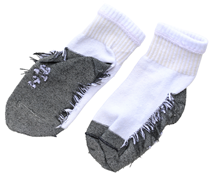 Putting clothes on the right way round is tricky. Most children still put their clothes on back to front sometimes when they start school. Some children can find this challenging as they move through school. As with all dressing skills it is best to start teaching this skill as soon as you can.
Putting clothes on the right way round is tricky. Most children still put their clothes on back to front sometimes when they start school. Some children can find this challenging as they move through school. As with all dressing skills it is best to start teaching this skill as soon as you can.
 Putting On and Taking Off a Jacket
Putting On and Taking Off a JacketBy 2 years your child should be able to take off their unfastened jacket. Between the ages of 3 and 4, your child should be able to put their jacket on. Although they may not manage zips and buttons.
Here are some tips to help:
Try these to find out what one works for your child:
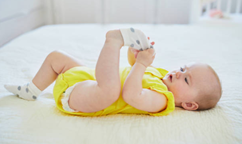 Babies love to take their socks off. They can usually manage this by themselves by the time they are 15 months old.
Babies love to take their socks off. They can usually manage this by themselves by the time they are 15 months old.
Putting on socks is a skill that children can often find challenging. It is particularly hard for children who have difficulties using both hands together.
Children learn to take their shoes off first. They can usually pull on wellies, slippers and slip-on shoes by the time they are 2 years old.



Here is a video from our OT colleagues in NHS Forth Valley for helping children put on their socks.
 Advice on what to look for and what to avoid when planning your child's nursery wardrobe.
Advice on what to look for and what to avoid when planning your child's nursery wardrobe.
Learning to do fastenings can be tricky. Like many other skills children need to be taught how to do these activities. Below you will find videos and resources to support you to teach your child how to un/do zips, buttons and shoelaces.
Zips are usually the first fastenings that children learn to do. Their first zip is usually on their jacket. Children will need help to put the zip together to start with.
To un/do buttons, both hands need to work together but make different movements.
Here are some ideas about how to teach your child to do zips and buttons.
You can find more information on our Zips Information Sheet and our Button Information Sheet.
Learning to tie shoelaces is hard. Learning to tie laces before you need to wear shoes that need to be tied is a good idea. Children don't usually have the skills they need to be able to tie their shoelaces until they are between five and seven.
Tips for young people:
Tips for adults:
This video has some hints and tips and shows you different ways to tie your laces.
Find our step by step guides below:
 is a good resource. It shows lots of different ways to lace shoes, tie shoelaces and stop shoelaces from coming undone.
is a good resource. It shows lots of different ways to lace shoes, tie shoelaces and stop shoelaces from coming undone.
As you move through school you might need to wear a school tie. You might just need a tie in school photographs or special occasions when you are at Primary School. Lots of secondary schools have a tie as part of the uniform and you might need to wear a school tie every day. It helps to be able to tie a tie by yourself so that changing for P.E. is not an issue.
Use the videos below to learn how to tie your tie.

 Use clip on or elastic ties.
Use clip on or elastic ties.  You might need some help with this strategy. Get someone to tie your tie as normal. Cut apart the back of the tie which would be under the collar. Sew Velcro onto both sides next to where you cut, like in the picture. Now you can use the Velcro fastening to put it on or take it off.
You might need some help with this strategy. Get someone to tie your tie as normal. Cut apart the back of the tie which would be under the collar. Sew Velcro onto both sides next to where you cut, like in the picture. Now you can use the Velcro fastening to put it on or take it off.Last reviewed Oct 2023.